- Home
- Carolyn Keene
The Clue in the Crossword Cipher Page 7
The Clue in the Crossword Cipher Read online
Page 7
“I do not know what this is intended for,” he said.
The piece was about eight inches long and three-quarters of an inch thick, with a tube inside the center of it.
“This is about the size and shape of handles of some of our salad forks and spoons, but we always keep them solid,” Senor Velez said.
“I found the wood under Luis Llosa’s bench, so I suppose it’s his,” Nancy told him.
The shop owner frowned even more deeply. “No doubt, but this wood did not come from my purchases. It is arrayánes.”
“What!” Nancy exclaimed.
“That is right,” the craftsman told her. “I cannot understand. Luis must have brought it here. I intend to ask him when he returns.” Señor Velez put the piece into his pocket.
Nancy’s mind was already filled with speculations about Llosa’s work. She said, “Maybe he intended to put something inside the handle.”
“Perhaps,” Senor Velez conceded. “But what? I will certainly make him tell me.”
On the way home Nancy told the other girls of her discovery. Instantly George said, “I’m sure he’s up to no good.”
That evening Carla had arranged a delightful party for the North American girls to meet some of her Peruvian friends.
“It was wonderful and I enjoyed getting to know your friends,” Nancy told Carla after the guests had left.
“And what marvelous dancers!” Bess exclaimed. “Oh, I could live here forever!”
“And have Dave down here fighting duels?” George grinned.
Before leaving for Cuzco the next day, Nancy telephoned Señor Velez. She found him upset. “My assistant has not come back and has sent no word. I called his home to find out why, but nobody was there.”
Nancy asked the shop owner if he had missed anything from his place of business. Senor Velez admitted that he had not thought of checking but would look immediately. “Hold the phone, please.”
Within two minutes he was back. “Luis has taken many of my tools! Oh, it is dreadful, dreadful! Some of them are very old and I cannot replace them!”
“I am sorry,” Nancy said. “You will report the theft to the police, of course?”
“Indeed. Indeed. And thank you, Miss Drew, for alerting me.”
Bess, George, and the Ponces were sorry to hear what had happened. They hoped that the police would pick up Luis Llosa quickly.
“I hope so too,” said Nancy. “I am also interested in how Llosa got his arrayánes wood and what he was doing with it. Remember the police in Bariloche found a quantity of similar wood in Wagner’s home. I feel sure he has been supplying Llosa with it.”
“Of course,” said George. “They’re part of the same gang. The question is, What are they doing with this wood?”
Carla’s mother said she was mortified that their old family mystery was causing such a furor.
Her husband smiled. “My dear,” he said, “aren’t you pleased that these evildoers are being apprehended?”
“Oh, yes,” Senora Ponce replied. “But I wish the girls could have more fun and less worry.”
Nancy put the plaque in her suitcase, then Carla’s father drove the girls to the airport. The plane to Cuzco was an old type which was not pressurized.
After it had been in the air a short while, the pilot announced that in order to go over the Andes they would have to fly at a great height, where the air was thin. The stewardess came to each passenger. She unfastened an oxygen tube from under the window and indicated that it was to be held near the mouth to keep from feeling faint.
The scenery below was very beautiful— mountain crags, forests, and streams blended into a breath-taking panorama. About two and a half hours later the pilot announced that the oxygen tubes were no longer needed. The plane was coming down into Cuzco.
The girls from River Heights, seeing the city from the air, were amazed at its size. They had expected it to be much smaller.
“Imagine living in the mountains twelve thousand feet above sea level!” said Bess.
“Yes,” George replied. “And I read in a guidebook this is known as a mountaintop valley. The people who lived here centuries ago were called ‘valley people.’ ”
When the plane landed, the four girls found a taxi and Carla suggested that the driver take them for a quick tour around the city before going to the hotel.
Fortunately he spoke English and evidently was quite experienced in lecturing to tourists. He began by pointing out the huge stones in the old foundations of buildings. “They were built by the Incas. When the Spanish came, they tore down temples and palaces but left the foundations and put their own buildings on top of them.”
The driver smiled. “The sun god punished them, though. When an earthquake came, the Spanish buildings fell over, but the foundations remained.”
Next, he showed the girls a narrow Incan street. Both sides of it had high stone walls and the driver stopped so the visitors could walk down a short distance to see the famous twelve-sided stone which was part of it. Each girl counted the sides and marveled at the way the ancient stonecutters had trimmed this enormous rock to accommodate the ones fitted around it.
The young tourists noticed that all the stones were so perfectly fitted that there was not one single opening or crack between them. Not even an earthquake could damage this amazing artisanship!
Presently the driver stopped again where a modern church had been built on the old Incan foundation. “This was where the Temple to the Sun once stood,” he explained. “Beyond it, at that time, was a beautiful park with trees, flowers, and golden statues. At the far end was a palace.”
“How I wish,” said Nancy, “that I could have seen them!”
The man smiled. “If you had been an Inca maiden, you would have been wearing a long, one-piece dress made of alpaca wool. Your hair would have been in long braids tied with many colored ribbons of wool. You would have worn sandals and perhaps a sash, as well as a long shawl to cover your head and hang far down the back.”
“It sounds very attractive,” she remarked.
“Perhaps you would like to buy such a dress for a souvenir,” the guide suggested.
All the girls wanted Incan dresses, so he took them to a shop where they purchased colorful shifts, two with zigzagging patterns in red and black, two with a llama design woven into the cloth.
“I can’t wait to wear mine at a party back home,” Bess said, giggling.
When the shopping was completed, the driver took the girls to their hotel and warned them to “take it easy.” “You would not want to get altitude sickness,” he said, smiling. “Walk slowly while you are here.”
They thanked him for the advice, but as soon as the girls had had lunch, Nancy said she thought they should find the old Indian Maponhni. She learned from the desk clerk that the Indian was well known and he directed the girls to the elderly man’s home. It was on a side street and proved to be of rather modem construction.
Carla smiled. “I half expected that Maponhni would be living in a stone hut with a thatched roof. But the Indians who live here today are quite modern. Many of them have transistor radios and are no longer isolated from the rest of the world.”
Nancy knocked on the door and it was opened by a pleasant-looking man, definitely a descendant of the Incas. He was of medium height, somewhat portly, and had large hands with small wrists. His head was broad, and he had high cheekbones and an aquiline nose. The man’s eyes were somewhat almond-shaped, like an Oriental’s, and his expression kindly and humorous.
“Senor Maponhni?” Nancy asked.
The Indian grinned. “Munanki! Imaynan caskianqui.”
Nancy’s eyes twinkled. “Hucclla,” she replied. “Yusul paiki.”
Maponhni looked stunned. In English he said, “You speak Quechua? Please come in, all of you.”
Nancy laughed and told him that they had heard about him from the guard at the arrayánes forest and that he had taught them the words. “He said you know more about Inca his
tory than anyone else.”
“He flatters me,” the Indian said. “But I will be happy to answer your questions.”
Nancy, who was carrying the plaque, now unwrapped it. Carla told of the ancient mystery.
“We thought you might help us figure out the crossword cipher.”
Maponhni started to examine the monkey side of the plaque. Suddenly everyone noticed that all the objects in the room were shaking.
The Indian laid the plaque on a table. When it nearly fell off, Nancy grabbed the plaque. The old man had begun to chant in Quechua.
“What’s happening?” Bess asked, looking around fearfully.
Carla’s face was pale. “An earthquake!” she gasped.
CHAPTER XII
The Boy Spy
As the earth tremors continued, Maponhni stopped his chanting and motioned for the others to follow him. Quickly he led the way into the kitchen and said this was an original Incan building with a modern roof.
“We will be safe here, I think,” he told them. “The old walls are sturdy.”
From outside came the cries of people and the sound of objects falling. The girls followed the man’s example of sitting cross-legged on the floor. No one spoke. All were too tense to do anything but wait. Then abruptly the shaking stopped.
Everyone heaved a sigh of relief and Carla said, “I hope this will not be followed by another quake.”
Maponhni said quietly, “Who knows? But I think it is over.”
Everyone was eager to go to the street and see what had happened.
“Be careful where you step,” the Indian warned.
Just outside the front door a boy about fifteen years old was lying on the ground, swaying from side to side and mumbling.
“You’re safe now,” Nancy said to him kindly.
The boy’s eyes were closed and he paid no attention to her. He kept on muttering the same thing over and over.
“What is he saying?” Bess asked the Indian.
Maponhni looked puzzled. “He is saying, ‘Oh, Cat, I must stop. The sun god has sent this sign. You say the girl is a spy? ... No, no. Go away, Cat. I will do nothing more for you.’ ”
“That’s a lot of gibberish,” George remarked. “What does he mean?”
“I do not know,” Maponhni replied.
He shook the boy, who finally opened his eyes. He looked around dazedly as the Indian helped him to his feet, then questioned him in Quechua.
A sudden look of terror came into the youth’s eyes. He stared hard at the four girls, gave a little cry as if in pain, and ran off down the street as fast as he could.
“Shall we chase him?” George asked.
“Yes!” cried Nancy.
Instantly Maponhni caught her arm. “No,” he said. “The boy has done no harm and you should not run in this rare atmosphere.”
“But he may be connected with our mystery,” Carla stated. “He mentioned ‘cat’—”
“We think this boy may be working for a man who calls himself El Gato,” Nancy explained. “He is wanted by your police. He intends to harm us. The boy may report to him where we are and what we’re doing!”
“I am sorry I stopped you,” Maponhni said. “Now it is too late to find the boy.”
Nancy asked the Indian if he had ever heard of a sinister character called El Gato.
“No. And I did not recognize the boy who mumbled those strange words. I know every Indian in Cuzco,” he told the girls. “This boy is a stranger here.”
“Then,” said Carla, “he might have been sent to Cuzco by El Gato.”
Nancy agreed, but said that perhaps the earthquake had frightened him so much he would not do any more work for El Gato. She explained to Maponhni about Carla having received the anonymous note: Beware of the cat.
“That is not good,” he said. “You girls take care.”
The group went back to the house and once more the Indian looked at the plaque. He studied it for a long time, then finally confessed that he could make nothing out of either side.
“I can tell you something, though, which may help you,” he said. “When I was a little boy I heard my great-grandmother tell a story which had been handed down in her family. It might concern your ancestor, Señorita Ponce.
“The story was about a fine Spanish artist-adventurer who came first to Cuzco and then went to Machu Picchu. He was well received by the people there and enjoyed his work. But after a while they made him a prisoner. We did not hear why.
“I do not know how long he was there,” Maponhni continued, “but it seems that he and an Indian companion escaped. They made their way here.
“The Indian knew an Inca priest. He secretly befriended them. But when the priest tried to question the Spaniard about why he had been a prisoner, the artist refused to tell anything. Shortly afterward, he and the Indian disappeared. Nothing more was ever heard of them. Years later, when the Inca priest was dying, he confessed to helping the runaways.”
“Did the story tell what the Spaniard’s name was?” Nancy asked. “Aguilar, perhaps?”
Maponhni shook his head. “The name I heard was not Spanish, but Quechuan. I have even forgotten what that was, but probably a name the Indians gave him.”
“Why,” Carla mused, “would the artist refuse to answer the Cuzco priest who befriended him?”
All the girls surmised that it might be because the man had discovered a secret he was afraid to tell. Or was he trying to keep some special information to himself until he could contact his family in Lima?
“Maybe,” Carla said thoughtfully, “this man was Aguilar.”
“It’s quite possible,” said Nancy. “After all, there were many adventurers at that time, but my guess is that a European artist in these parts was unusual.”
Maponhni nodded. “You say you think this plaque indicates something valuable like a treasure? What do you expect to find—Inca gold?”
“Who knows?” George replied. “A really fabulous object may be buried somewhere. All we have to do is find the spot.”
Maponhni advised them to spend a day or two at the ruins of Machu Picchu. “What destroyed the city is a great mystery. I guess you know that. Maybe your treasure is buried there.”
The girls thanked the Indian for his help. Before they left, he asked if he might take them the next day to see the ruins at Sacsahuaman. “They are just outside of town and an amazing sight. Sacsahuaman was originally a fort.”
The girls said they would like very much to go and would be ready at ten o’clock.
The following morning Maponhni came to their hotel with his car and they started off. When they reached the ruins, the visitors stood in awe.
“How magnincent!” Nancy exclaimed, gazing at the high zigzagging stonework that formed the front of the fortress.
Maponhni said the wide three-tiered wall, made entirely of huge limestone boulders, was sixty feet high and eighteen hundred feet long.
“Some of these rocks weigh two hundred tons and were brought here without the aid of any kind of machinery. Men tumbled them end over end, using strong, slender tree trunks for leverage.”
“How did the workmen get one rock on top of the other?” Bess asked.
Maponhni said that great mounds of dirt were piled up and the stones rolled up them and put into place. “Then the mound would be made higher so the next rock could be raised to position.”
“It’s a fantastic piece of engineering,” Nancy remarked. “I’d like to climb up and look around.” The others decided to try it also.
“Go ahead, but be carefull” the Indian warned. “I will wait here.”
While they had been talking, a car had driven into the far side of the grassy area. It continued in a huge semicircle and stopped near the end of the fortress wall, about five hundred feet from the girls.
At first they thought there was only the driver, but suddenly a man arose from the rear seat and disappeared behind the last jog of the wall. He was carrying something half under his jacke
t, as if he were trying to conceal it.
“What was he holding?” Carla asked.
“It looked like a big can,” Nancy replied.
The girls hunted for tiny worn places in the rocks as footholds to pull themselves up toward the first level of the fortress. Nancy reached it ahead of the others and hurried along the walkway. Eager to get to the top, she climbed to the second tier and was soon out of sight of the others.
“What a place for a siege!” Nancy thought, gazing around, then she walked forward.
Near the end of the wall she started downward in a slanting direction. When she was about twenty feet from the ground she heard a noise above her. She looked up just in time to glimpse a man’s leg disappearing around the adjoining bend in the zigzag wall.
Suddenly Nancy gasped in astonishment. On a large rock above her was the newly painted, crude face of a bright-red cat!
CHAPTER XIII
El Gato
THE cat again!
“Maybe that man who painted it was El Gato himself, leaving his insigne!” Nancy thought.
She tried to peer around the corner of the zigzag wall, but could not do so without losing her balance. “I wish I could see him!” she fumed.
Wondering if he might have returned to his car, Nancy turned to gaze below. The driver was still there, but the other man was not in sight.
Nancy changed her position to look upward again. She saw an arm poke itself around the corner. The arm disappeared for a second, then reappeared. This time the hand was holding a bucket with red paint dripping over the sides.
Nancy was puzzled. “Is the man going to add to his picture?” she thought.
As she stood fascinated by the prospect, the hand suddenly swung upward. With great force the hidden figure threw the bucket of red paint directly toward her.
Nancy knew that she had to move in a hurry, but there was no place she could run from her precarious position! She must jump!
Hoping to land on the soft grass below, Nancy leaped off the side of the fortress. It was a long jump. She took it gracefully, but landed with bone-jarring impact and sat down, breathless, without moving. The can now lay in a red gooey mass not far from her.

 The Purple Fingerprint
The Purple Fingerprint The Picture of Guilt
The Picture of Guilt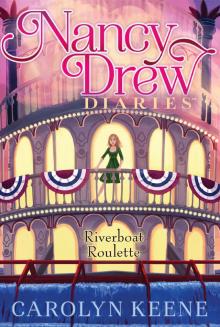 Riverboat Roulette
Riverboat Roulette The Singing Suspects
The Singing Suspects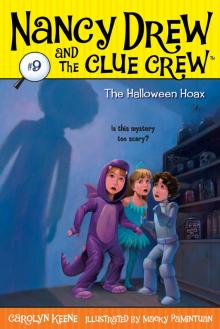 The Halloween Hoax
The Halloween Hoax 089 Designs in Crime
089 Designs in Crime The Hidden Treasures
The Hidden Treasures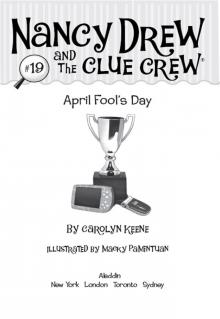 April Fool's Day
April Fool's Day The Black Widow
The Black Widow Final Notes
Final Notes The Haunting on Heliotrope Lane
The Haunting on Heliotrope Lane The Runaway Bride
The Runaway Bride The Ghost of Grey Fox Inn
The Ghost of Grey Fox Inn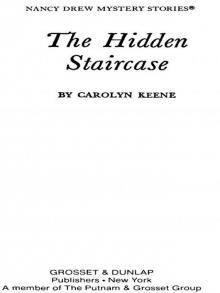 The Hidden Staircase
The Hidden Staircase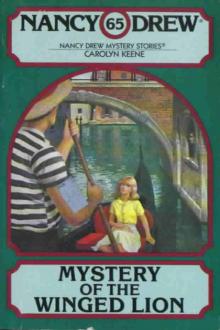 Mystery of the Winged Lion
Mystery of the Winged Lion Over the Edge
Over the Edge The Circus Scare
The Circus Scare The Mystery of the Brass-Bound Trunk
The Mystery of the Brass-Bound Trunk Ski School Sneak
Ski School Sneak Designed for Disaster
Designed for Disaster The Clue in the Glue
The Clue in the Glue Cold as Ice
Cold as Ice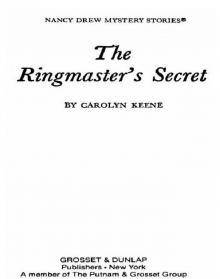 The Ringmaster's Secret
The Ringmaster's Secret 013 Wings of Fear
013 Wings of Fear The Secret of Shadow Ranch
The Secret of Shadow Ranch Not Nice on Ice
Not Nice on Ice Earth Day Escapade
Earth Day Escapade Mystery of Crocodile Island
Mystery of Crocodile Island The Bungalow Mystery
The Bungalow Mystery Power of Suggestion
Power of Suggestion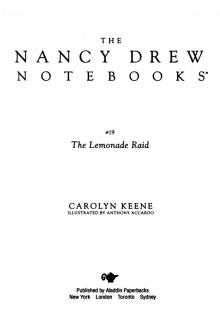 The Lemonade Raid
The Lemonade Raid Model Crime
Model Crime The Lucky Horseshoes
The Lucky Horseshoes The Secret of the Old Clock
The Secret of the Old Clock The Clue at Black Creek Farm
The Clue at Black Creek Farm Pure Poison
Pure Poison Nobody's Business
Nobody's Business Wrong Track
Wrong Track Chick-Napped!
Chick-Napped! Captive Witness
Captive Witness If Looks Could Kill
If Looks Could Kill The Mysterious Mannequin
The Mysterious Mannequin White Water Terror
White Water Terror Mystery of the Midnight Rider
Mystery of the Midnight Rider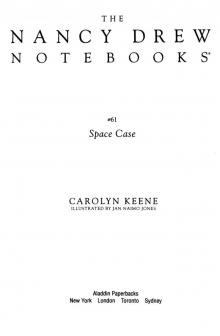 Space Case
Space Case World Record Mystery
World Record Mystery Hotline to Danger
Hotline to Danger The Red Slippers
The Red Slippers A Crime for Christmas
A Crime for Christmas A Musical Mess
A Musical Mess The Dollhouse Mystery
The Dollhouse Mystery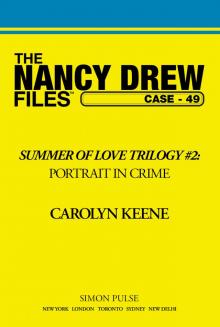 Portrait in Crime
Portrait in Crime The Message in the Haunted Mansion
The Message in the Haunted Mansion Playing With Fire
Playing With Fire Mystery of the Tolling Bell
Mystery of the Tolling Bell Cutting Edge
Cutting Edge The Gumdrop Ghost
The Gumdrop Ghost The Message in the Hollow Oak
The Message in the Hollow Oak Trial by Fire
Trial by Fire Mystery at Moorsea Manor
Mystery at Moorsea Manor Princess on Parade
Princess on Parade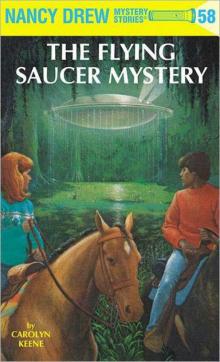 The Flying Saucer Mystery
The Flying Saucer Mystery 035 Bad Medicine
035 Bad Medicine 055 Don't Look Twice
055 Don't Look Twice The Haunted Showboat
The Haunted Showboat Out of Bounds
Out of Bounds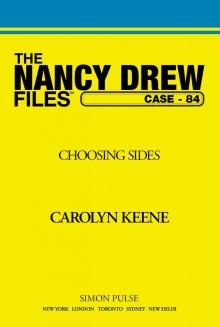 Choosing Sides
Choosing Sides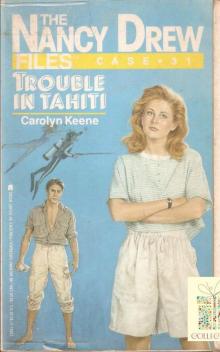 031 Trouble in Tahiti
031 Trouble in Tahiti The Suspect Next Door
The Suspect Next Door The Clue of the Black Keys
The Clue of the Black Keys The Secret Santa
The Secret Santa Race Against Time
Race Against Time 027 Most Likely to Die
027 Most Likely to Die The Cheating Heart
The Cheating Heart Dangerous Relations
Dangerous Relations It's No Joke!
It's No Joke! The Mystery of the Mother Wolf
The Mystery of the Mother Wolf 097 Squeeze Play
097 Squeeze Play Secret at Mystic Lake
Secret at Mystic Lake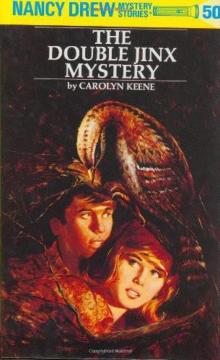 The Double Jinx Mystery
The Double Jinx Mystery The Walkie Talkie Mystery
The Walkie Talkie Mystery The Case of the Vanishing Veil
The Case of the Vanishing Veil The Mystery of the 99 Steps
The Mystery of the 99 Steps The Stolen Bones
The Stolen Bones The Clue of the Dancing Puppet
The Clue of the Dancing Puppet The Sand Castle Mystery
The Sand Castle Mystery A Model Crime
A Model Crime The Witch Tree Symbol
The Witch Tree Symbol The Case of the Artful Crime
The Case of the Artful Crime Mall Madness
Mall Madness Swiss Secrets
Swiss Secrets The Magician's Secret
The Magician's Secret Tall, Dark and Deadly
Tall, Dark and Deadly The Silver Cobweb
The Silver Cobweb The Clue of the Gold Doubloons
The Clue of the Gold Doubloons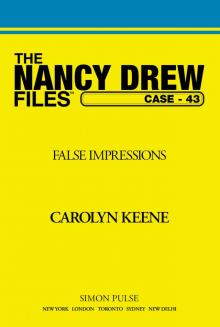 False Impressions
False Impressions Model Suspect
Model Suspect Stay Tuned for Danger
Stay Tuned for Danger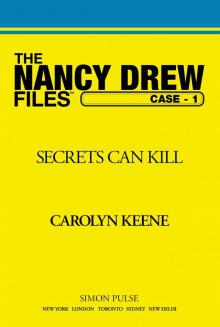 Secrets Can Kill
Secrets Can Kill The Bunny-Hop Hoax
The Bunny-Hop Hoax The Cinderella Ballet Mystery
The Cinderella Ballet Mystery The Secret at Solaire
The Secret at Solaire Trash or Treasure?
Trash or Treasure? The Missing Horse Mystery
The Missing Horse Mystery The Lost Locket
The Lost Locket The Secret of the Wooden Lady
The Secret of the Wooden Lady Password to Larkspur Lane
Password to Larkspur Lane Movie Madness
Movie Madness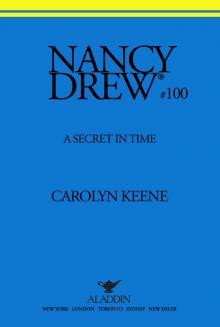 A Secret in Time
A Secret in Time The Twin Dilemma
The Twin Dilemma Candy Is Dandy
Candy Is Dandy Murder on Ice
Murder on Ice Dude Ranch Detective
Dude Ranch Detective The Slumber Party Secret
The Slumber Party Secret The Clue in the Old Stagecoach
The Clue in the Old Stagecoach Danger on Parade
Danger on Parade Big Top Flop
Big Top Flop Strangers on a Train
Strangers on a Train 087 Moving Target
087 Moving Target The Scarytales Sleepover
The Scarytales Sleepover The Mystery of the Fire Dragon
The Mystery of the Fire Dragon The Carousel Mystery
The Carousel Mystery The Eskimo's Secret
The Eskimo's Secret Thrill on the Hill
Thrill on the Hill 032 High Marks for Malice
032 High Marks for Malice Enemy Match
Enemy Match Poison Pen
Poison Pen Lights, Camera . . . Cats!
Lights, Camera . . . Cats! Lost in the Everglades
Lost in the Everglades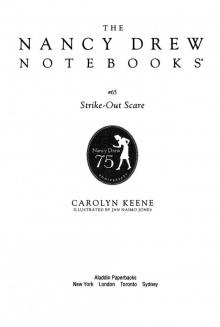 Strike-Out Scare
Strike-Out Scare Third-Grade Reporter
Third-Grade Reporter Sea of Suspicion
Sea of Suspicion Wedding Day Disaster
Wedding Day Disaster The Make-A-Pet Mystery
The Make-A-Pet Mystery The Ski Slope Mystery
The Ski Slope Mystery Pony Problems
Pony Problems Candy Kingdom Chaos
Candy Kingdom Chaos The Sign in the Smoke
The Sign in the Smoke The Wrong Chemistry
The Wrong Chemistry Circus Act
Circus Act Sinister Paradise
Sinister Paradise This Side of Evil
This Side of Evil Deadly Doubles
Deadly Doubles The Mystery of the Masked Rider
The Mystery of the Masked Rider The Secret in the Old Lace
The Secret in the Old Lace The Pen Pal Puzzle
The Pen Pal Puzzle Without a Trace
Without a Trace Whose Pet Is Best?
Whose Pet Is Best? Dance Till You Die
Dance Till You Die Trail of Lies
Trail of Lies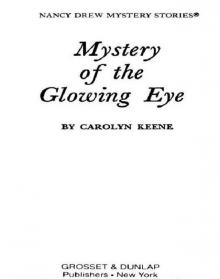 Mystery of the Glowing Eye
Mystery of the Glowing Eye The Clue of the Leaning Chimney
The Clue of the Leaning Chimney The Crook Who Took the Book
The Crook Who Took the Book Danger for Hire
Danger for Hire Thanksgiving Thief
Thanksgiving Thief Intruder!
Intruder!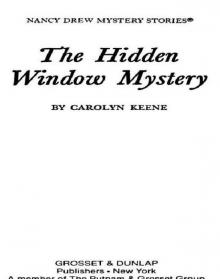 The Hidden Window Mystery
The Hidden Window Mystery Win, Place or Die
Win, Place or Die Danger in Disguise
Danger in Disguise The Best Detective
The Best Detective The Thanksgiving Surprise
The Thanksgiving Surprise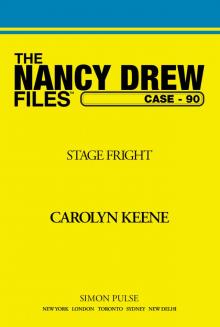 Stage Fright
Stage Fright The Kitten Caper
The Kitten Caper Stolen Affections
Stolen Affections The Phantom of Nantucket
The Phantom of Nantucket Date With Deception
Date With Deception Cooking Camp Disaster
Cooking Camp Disaster The Mystery at Lilac Inn
The Mystery at Lilac Inn Springtime Crime
Springtime Crime Action!
Action! Into Thin Air
Into Thin Air The Chocolate-Covered Contest
The Chocolate-Covered Contest 025 Rich and Dangerous
025 Rich and Dangerous Bad Times, Big Crimes
Bad Times, Big Crimes 078 The Phantom Of Venice
078 The Phantom Of Venice The Stolen Kiss
The Stolen Kiss Running Scared
Running Scared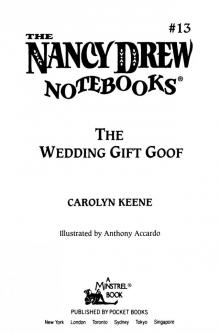 The Wedding Gift Goof
The Wedding Gift Goof Time Thief
Time Thief The Phantom of Pine Hill
The Phantom of Pine Hill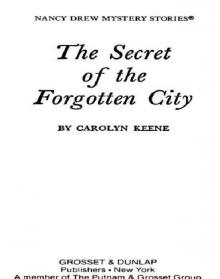 The Secret of the Forgotten City
The Secret of the Forgotten City The Emerald-Eyed Cat Mystery
The Emerald-Eyed Cat Mystery 004 Smile and Say Murder
004 Smile and Say Murder Curse of the Arctic Star
Curse of the Arctic Star Dinosaur Alert!
Dinosaur Alert! The Case of the Photo Finish
The Case of the Photo Finish Kiss and Tell
Kiss and Tell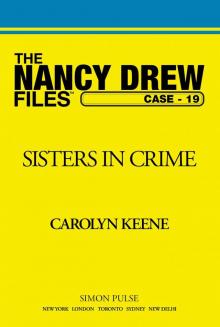 Sisters in Crime
Sisters in Crime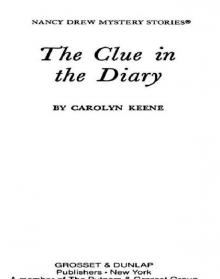 The Clue in the Diary
The Clue in the Diary 084 Choosing Sides
084 Choosing Sides Haunting of Horse Island
Haunting of Horse Island Vanishing Act
Vanishing Act The Big Island Burglary
The Big Island Burglary Danger at the Iron Dragon
Danger at the Iron Dragon Pets on Parade
Pets on Parade Something to Hide
Something to Hide The Strange Message in the Parchment
The Strange Message in the Parchment On the Trail of Trouble
On the Trail of Trouble Heart of Danger
Heart of Danger The Snowman Surprise
The Snowman Surprise Model Menace
Model Menace Flower Power
Flower Power The Great Goat Gaffe
The Great Goat Gaffe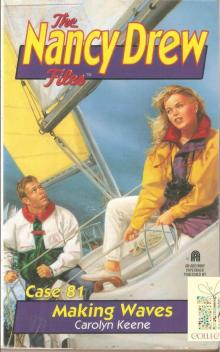 081 Making Waves
081 Making Waves Famous Mistakes
Famous Mistakes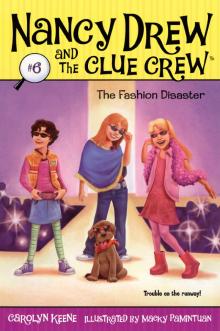 The Fashion Disaster
The Fashion Disaster The Clue in the Jewel Box
The Clue in the Jewel Box The Clue of the Whistling Bagpipes
The Clue of the Whistling Bagpipes Make No Mistake
Make No Mistake Greek Odyssey
Greek Odyssey Flirting With Danger
Flirting With Danger Double Take
Double Take Trouble Takes the Cake
Trouble Takes the Cake Turkey Trouble
Turkey Trouble The Day Camp Disaster
The Day Camp Disaster The Secret in the Old Attic
The Secret in the Old Attic The Baby-Sitter Burglaries
The Baby-Sitter Burglaries Recipe for Murder
Recipe for Murder The Secret of the Scarecrow
The Secret of the Scarecrow Cat Burglar Caper
Cat Burglar Caper Turkey Trot Plot
Turkey Trot Plot Scent of Danger
Scent of Danger The Clue in the Crossword Cipher
The Clue in the Crossword Cipher 010 Buried Secrets
010 Buried Secrets A Talent for Murder
A Talent for Murder The Triple Hoax
The Triple Hoax The Clue of the Velvet Mask
The Clue of the Velvet Mask Last Lemonade Standing
Last Lemonade Standing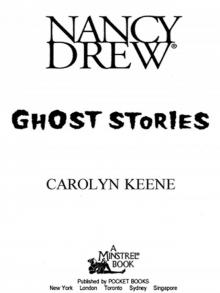 The Ghost of Blackwood Hall
The Ghost of Blackwood Hall The Black Velvet Mystery
The Black Velvet Mystery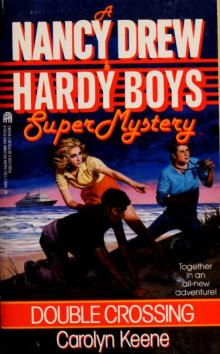 Double Crossing
Double Crossing Hidden Meanings
Hidden Meanings Trouble at Camp Treehouse
Trouble at Camp Treehouse An Instinct for Trouble
An Instinct for Trouble 037 Last Dance
037 Last Dance 038 The Final Scene
038 The Final Scene Duck Derby Debacle
Duck Derby Debacle The Pumpkin Patch Puzzle
The Pumpkin Patch Puzzle Hidden Pictures
Hidden Pictures Buggy Breakout
Buggy Breakout California Schemin'
California Schemin' Clue in the Ancient Disguise
Clue in the Ancient Disguise Case of the Sneaky Snowman
Case of the Sneaky Snowman 034 Vanishing Act
034 Vanishing Act A Script for Danger
A Script for Danger The Flower Show Fiasco
The Flower Show Fiasco Shadow of a Doubt
Shadow of a Doubt Easy Marks
Easy Marks Alien in the Classroom
Alien in the Classroom Ghost Stories, #2 (Nancy Drew)
Ghost Stories, #2 (Nancy Drew) The Bike Race Mystery
The Bike Race Mystery False Pretenses
False Pretenses The Kachina Doll Mystery
The Kachina Doll Mystery Designs in Crime
Designs in Crime False Notes
False Notes The Haunted Carousel
The Haunted Carousel Bad Day for Ballet
Bad Day for Ballet Very Deadly Yours
Very Deadly Yours The Fine-Feathered Mystery
The Fine-Feathered Mystery Circle of Evil
Circle of Evil The Crooked Banister
The Crooked Banister 005 Hit and Run Holiday
005 Hit and Run Holiday The Spider Sapphire Mystery
The Spider Sapphire Mystery The Swami's Ring
The Swami's Ring The Secret of the Golden Pavilion
The Secret of the Golden Pavilion Recipe for Trouble
Recipe for Trouble Betrayed by Love
Betrayed by Love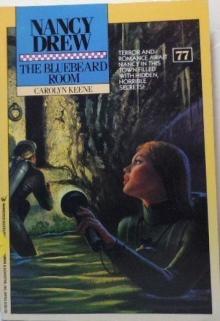 The Bluebeard Room
The Bluebeard Room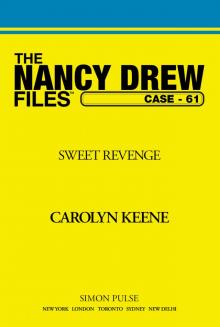 Sweet Revenge
Sweet Revenge Illusions of Evil
Illusions of Evil 006 White Water Terror
006 White Water Terror High Risk
High Risk Sleepover Sleuths
Sleepover Sleuths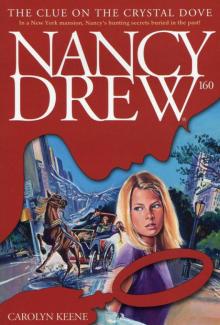 The Clue on the Crystal Dove
The Clue on the Crystal Dove The Stolen Unicorn
The Stolen Unicorn The Professor and the Puzzle
The Professor and the Puzzle The Elusive Heiress
The Elusive Heiress Stalk, Don't Run
Stalk, Don't Run The Mystery at the Moss-Covered Mansion
The Mystery at the Moss-Covered Mansion The Tortoise and the Scare
The Tortoise and the Scare 028 The Black Widow
028 The Black Widow Big Worry in Wonderland
Big Worry in Wonderland Crosscurrents
Crosscurrents The Dashing Dog Mystery
The Dashing Dog Mystery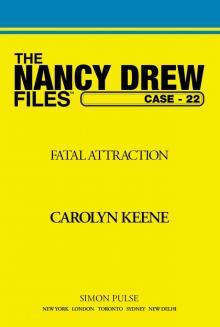 Fatal Attraction
Fatal Attraction The Clue of the Broken Locket
The Clue of the Broken Locket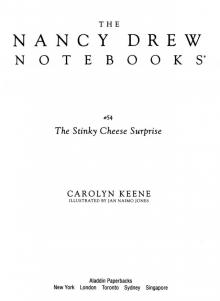 The Stinky Cheese Surprise
The Stinky Cheese Surprise Mystery of the Ivory Charm
Mystery of the Ivory Charm A Race Against Time
A Race Against Time Cape Mermaid Mystery
Cape Mermaid Mystery 085 Sea of Suspicion
085 Sea of Suspicion 058 Hot Pursuit
058 Hot Pursuit The Secret in the Spooky Woods
The Secret in the Spooky Woods The Mysterious Image
The Mysterious Image Fatal Ransom
Fatal Ransom The Stolen Show
The Stolen Show The Sinister Omen
The Sinister Omen The Secret of Mirror Bay
The Secret of Mirror Bay Rendezvous in Rome
Rendezvous in Rome The Perfect Plot
The Perfect Plot The Mystery of Misty Canyon
The Mystery of Misty Canyon Nancy's Mysterious Letter
Nancy's Mysterious Letter The Snow Queen's Surprise
The Snow Queen's Surprise The Clue in the Crumbling Wall
The Clue in the Crumbling Wall Dare at the Fair
Dare at the Fair Scream for Ice Cream
Scream for Ice Cream A Star Witness
A Star Witness 002 Deadly Intent
002 Deadly Intent Museum Mayhem
Museum Mayhem The Moonstone Castle Mystery
The Moonstone Castle Mystery The Whispering Statue
The Whispering Statue The Scarlet Slipper Mystery
The Scarlet Slipper Mystery Mystery at the Ski Jump
Mystery at the Ski Jump Hot Pursuit
Hot Pursuit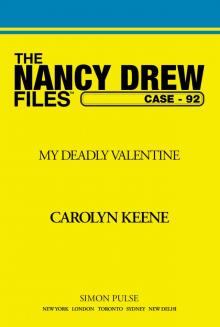 My Deadly Valentine
My Deadly Valentine The Silent Suspect
The Silent Suspect Deep Secrets
Deep Secrets False Moves
False Moves The Zoo Crew
The Zoo Crew Diamond Deceit
Diamond Deceit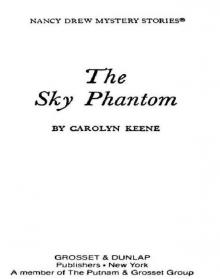 The Sky Phantom
The Sky Phantom 015 Trial by Fire
015 Trial by Fire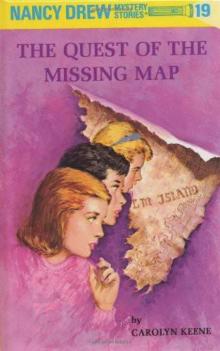 The Quest of the Missing Map
The Quest of the Missing Map Babysitting Bandit
Babysitting Bandit Don't Look Twice
Don't Look Twice Never Say Die
Never Say Die The Soccer Shoe Clue
The Soccer Shoe Clue Pool Party Puzzler
Pool Party Puzzler The Case of the Lost Song
The Case of the Lost Song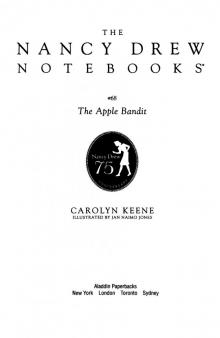 The Apple Bandit
The Apple Bandit No Laughing Matter
No Laughing Matter The Thirteenth Pearl
The Thirteenth Pearl Sabotage at Willow Woods
Sabotage at Willow Woods Butterfly Blues
Butterfly Blues Model Crime 1
Model Crime 1 The Nancy Drew Sleuth Book
The Nancy Drew Sleuth Book Mystery by Moonlight
Mystery by Moonlight Club Dread
Club Dread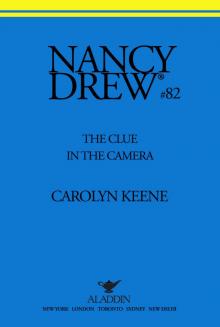 The Clue in the Camera
The Clue in the Camera 118 Betrayed By Love
118 Betrayed By Love The E-Mail Mystery (Nancy Drew Book 144)
The E-Mail Mystery (Nancy Drew Book 144) Stay Tuned for Danger: Circle of Evil
Stay Tuned for Danger: Circle of Evil Model Menace 2
Model Menace 2 California Schemin': Book One in the Malibu Mayhem Trilogy
California Schemin': Book One in the Malibu Mayhem Trilogy Zoo Clue (Nancy Drew Notebooks)
Zoo Clue (Nancy Drew Notebooks) False Pretences
False Pretences 151 The Chocolate-Covered Contest
151 The Chocolate-Covered Contest Close Encounters
Close Encounters The Emeral-Eyed Cat Mystery
The Emeral-Eyed Cat Mystery Boo Crew
Boo Crew The Message in the Haunted Mansion (Nancy Drew Book 122)
The Message in the Haunted Mansion (Nancy Drew Book 122) A Nancy Drew Christmas
A Nancy Drew Christmas 149 The Clue Of The Gold Doubloons
149 The Clue Of The Gold Doubloons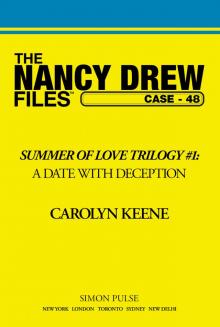 A Date with Deception
A Date with Deception 101 The Picture of Guilt
101 The Picture of Guilt The Secret in the Spooky Woods (Nancy Drew Notebooks Book 62)
The Secret in the Spooky Woods (Nancy Drew Notebooks Book 62) The Wrong Track
The Wrong Track Lights! Camera! Clues!
Lights! Camera! Clues! The Vanishing Act
The Vanishing Act Lights, Camera . . .
Lights, Camera . . . Model Suspect 3
Model Suspect 3 160 The Clue On The Crystal Dove
160 The Clue On The Crystal Dove 163 The Clues Challenge
163 The Clues Challenge Ghost Stories (Nancy Drew)
Ghost Stories (Nancy Drew) Space Case (Nancy Drew Notebooks Book 61)
Space Case (Nancy Drew Notebooks Book 61) 164 The Mystery Of The Mother Wolf
164 The Mystery Of The Mother Wolf 148 On The Trail Of Trouble
148 On The Trail Of Trouble The Walkie-Talkie Mystery
The Walkie-Talkie Mystery The E-Mail Mystery
The E-Mail Mystery Intruder (Nancy Drew (All New) Girl Detective)
Intruder (Nancy Drew (All New) Girl Detective)![The Stolen Relic [Nancy Drew Girl Detective 007] Read online](http://i1.bookreadfree.com/i2/04/11/the_stolen_relic_nancy_drew_girl_detective_007_preview.jpg) The Stolen Relic [Nancy Drew Girl Detective 007]
The Stolen Relic [Nancy Drew Girl Detective 007] 105 Stolen Affections
105 Stolen Affections An Instict for Trouble
An Instict for Trouble 161 Lost In The Everglades
161 Lost In The Everglades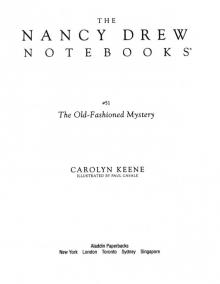 The Old-Fashioned Mystery
The Old-Fashioned Mystery Perfect Plot
Perfect Plot